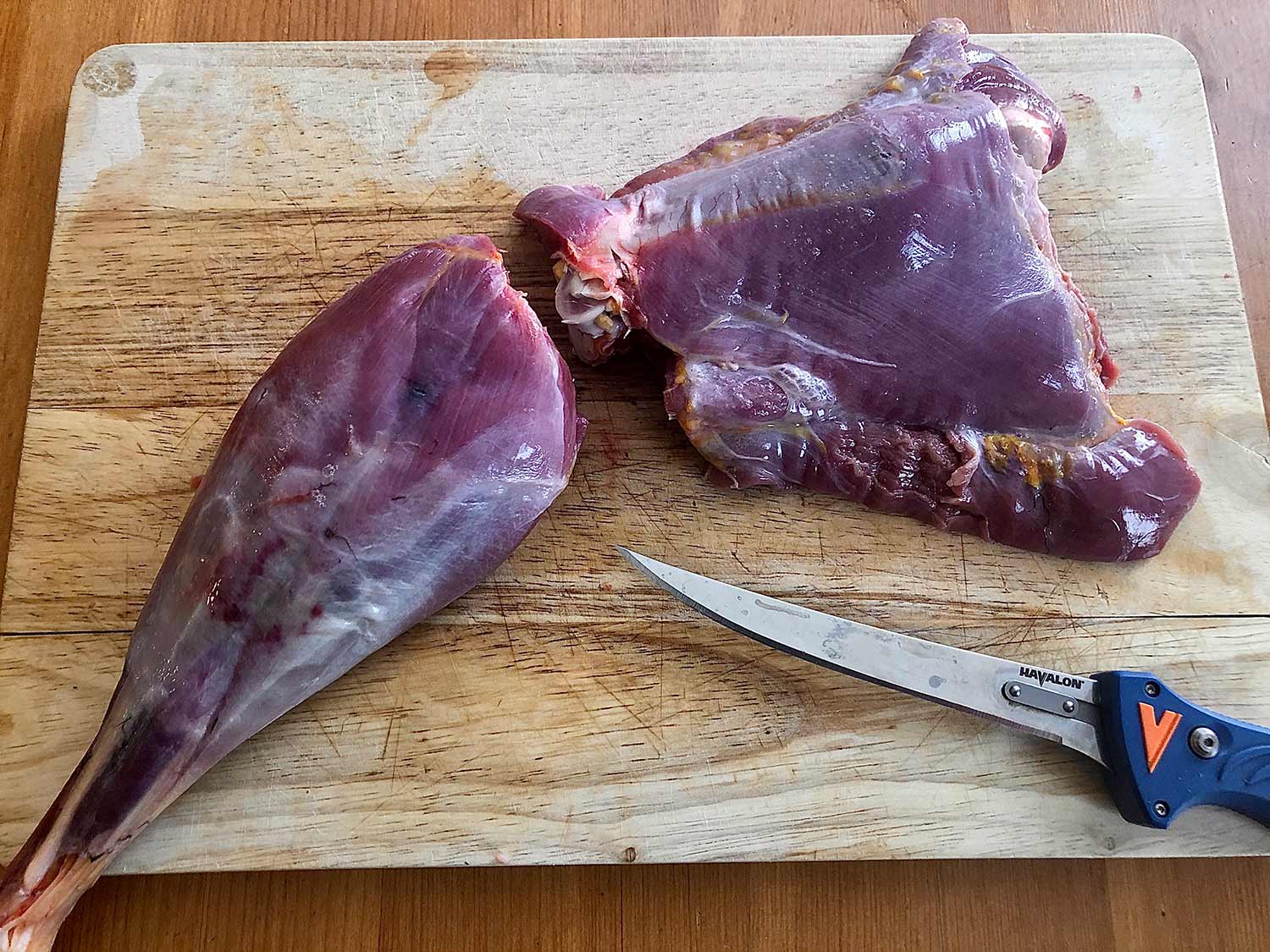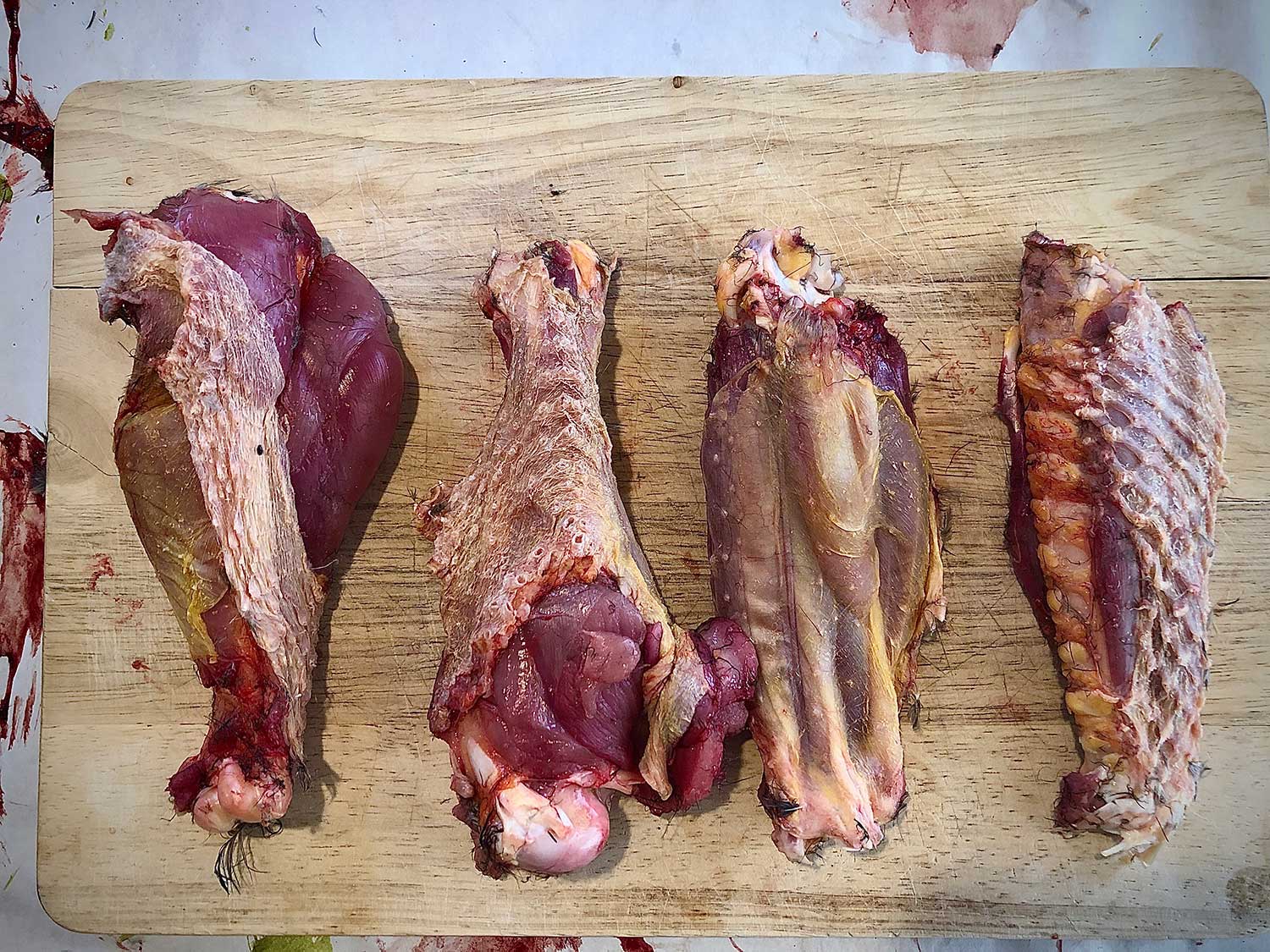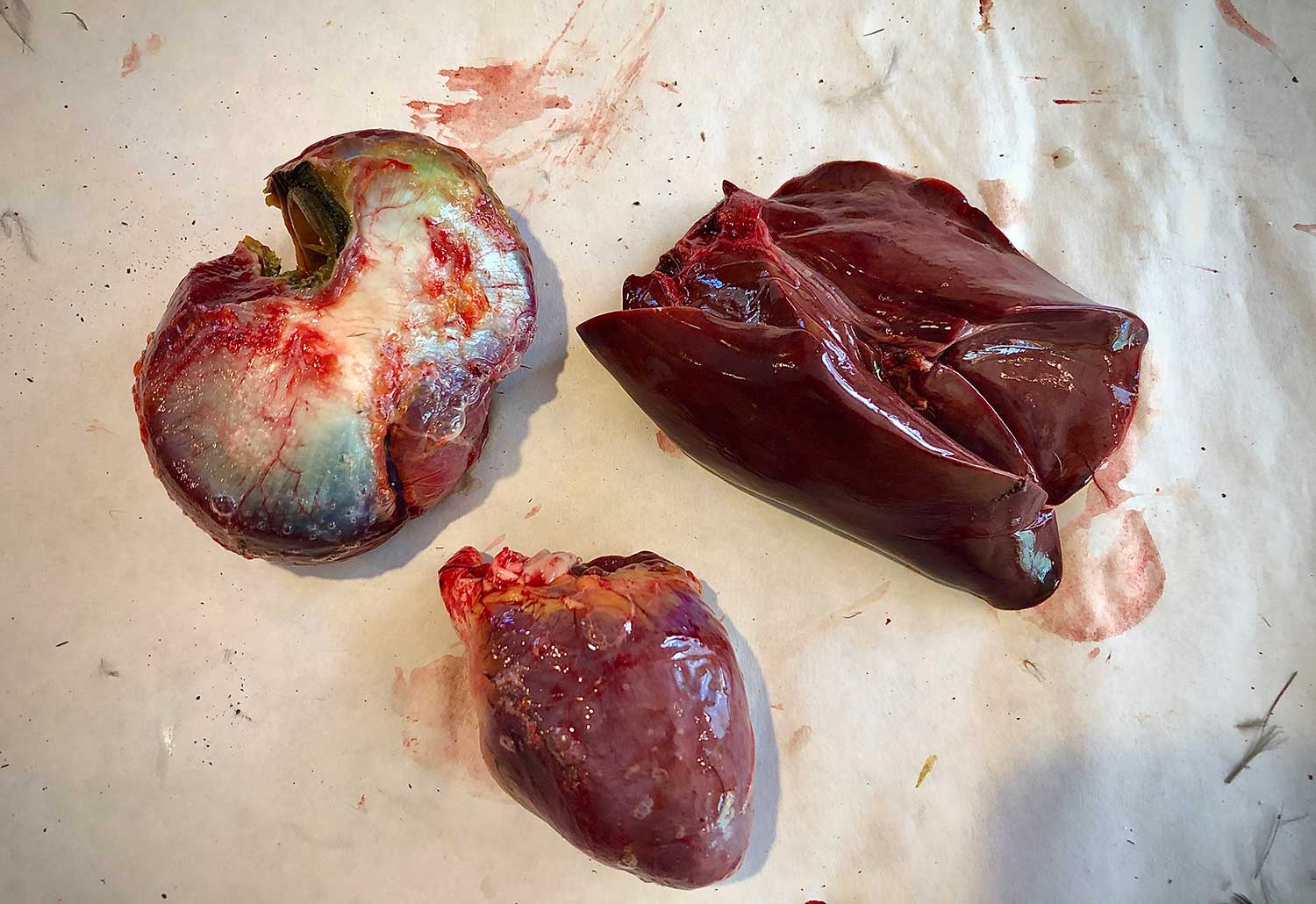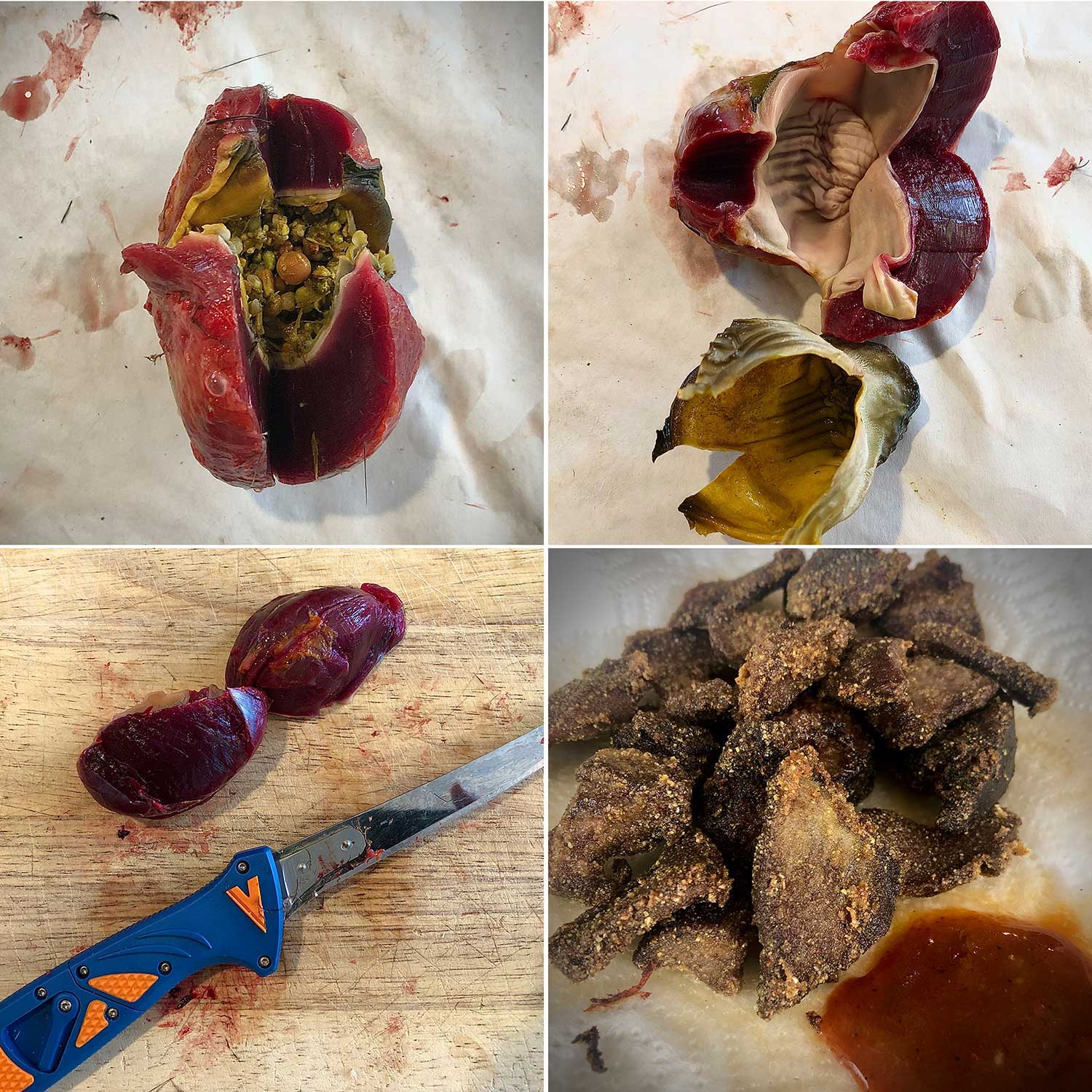Wild turkey is my all-time favorite game meat. Fried turkey nuggets dipped in hot barbecue sauce are practically unbeatable. They’re also very simple to prepare and have a rich flavor. Talk to any serious turkey hunter, and they’ll agree. However, not all turkey hunters know how to butcher a turkey and get every cut of meat.
In the video below, my turkey hunting buddy Josh Dahlke does an excellent job of breaking down the basic steps involved in butchering a wild turkey. With most of the birds I shoot, I follow the exact same process Dahlke uses here.
But sometimes, I want more than just the breasts and legs. I want to savor every bite of that turkey because some are killed on hunts that have greater significance, so I want to extend that hunt just a little bit. Here are the main cuts and organs you can harvest when you butcher a turkey:
The video above shows how to remove the most common cuts, which are on the breasts and legs, also known as the drumsticks and thighs. Wild turkey wings are often overlooked, mostly because they are a hassle to pluck and clean. But harvesting turkey wings requires a lot of work, but the rewards are surprisingly meaty cuts that can be made into a delectable buffalo wing recipe. The giblets consist of the gizzard, heart, and liver. Heart and gizzard meat have a similar texture when deep-fried and dipped in spicy sauce; they are both rich and slightly chewy, but in a good way. The liver, of course, has more of an iron taste.
Everyone takes the breast meat from their turkeys. But not everybody gets all the breast meat they should. The key to leaving no meat on the bone is to use an ultra-sharp, flexible blade. You don’t want to use your thick deer hunting knife for this job. The breastbone has curves and angles that you need to work the blade around. It’s more like filleting a fish than quartering a deer. (Read our review of the best hunting knives, here. ).
Furthermore, the amount of breast meat on a turkey increases dramatically on what I would call the bird’s shoulder. Peel back the skin all the way up to the wing to make sure you don’t miss any of that golden meat. Once you have removed every breast from your bird, you should consider freezing each piece of meat. To have enough turkey breast meat for four dinners, I like to cut each breast in half on a big tom. The top of the breast is thicker and has an almost roast-like consistency. I’m going to cut the breast in half, making one thick, narrow cut and one wider, thinner cut.
The culmination of raising turkeys often leads to the inevitable moment of harvest. While the process may seem daunting at first, understanding the proper techniques and embracing ethical practices ensures a humane and efficient experience. This guide will equip you with the knowledge and confidence to navigate the turkey harvesting process with skill and respect.
Preparing for the Task:
Before embarking on the harvest, meticulous preparation is key. Gather the necessary tools, including a sharp knife, poultry shears, a scalding pot, a plucker (optional), and a clean work surface. Ensure the area is well-lit and free from distractions.
Humane Handling:
Treating turkeys with respect and minimizing stress throughout the process is paramount. Handle the birds gently and avoid loud noises or sudden movements. Confine the turkey in a calm and quiet environment before proceeding.
Stunning the Turkey:
Stunning the turkey prior to slaughter renders it unconscious, minimizing suffering. Several methods exist, including cervical dislocation and electrical stunning. If unsure, consult a veterinarian or experienced poultry processor for guidance.
Slaughtering and Bleeding:
Once stunned, make a swift and precise cut across the jugular vein, allowing for thorough bleeding. This step is crucial for ensuring proper blood drainage and improving meat quality.
Scalding and Plucking:
The feathers become looser after the turkey is scalded in hot water (about 140°F), making plucking them easier. Alternatively, a plucker can be used for faster and more efficient feather removal.
Evisceration and Cleaning:
After plucking, carefully remove the internal organs, including the heart, liver, and gizzards. Dispose of these organs responsibly or utilize them for culinary purposes. Clean the cavity thoroughly with cold water to remove any remaining debris.
Chilling and Aging:
Once cleaned, chill the turkey thoroughly in a refrigerator or ice bath. Aging the turkey for a few days enhances tenderness and flavor.
Additional Considerations:
- Hygiene is paramount throughout the process. Wash your hands frequently and disinfect all surfaces and equipment.
- Wear appropriate protective gear, including gloves and an apron, to prevent contamination.
- If unsure about any aspect of the process, seek guidance from experienced individuals or consult reliable resources.
Respecting the Harvest:
Remember, harvesting a turkey is not merely a task; it’s a culmination of care and responsibility. By embracing ethical practices and utilizing proper techniques, you honor the life of the animal and ensure the highest quality of meat for your table.
Additional Resources:
- National Turkey Federation: https://www.eatturkey.com/
- University of Minnesota Extension: https://extension.umn.edu/preserving-and-preparing/harvesting-and-processing-poultry
Separate the Drumstick from Thigh

The key here is to separate the drumsticks from the thighs because they are anatomically different. The drumsticks have thick, heavy tendons running through them vertically, almost like the spokes of a bicycle wheel. No matter how you prepare the drumsticks, you won’t be able to cook down these tendons. So, you’ll need to shred the meat of the drumsticks. The thighs have tendons too, but they are not nearly as thick. By slowly cooking the thighs, you can get delicious dark meat and get rid of the chewiness from these tendons. Eating two people with just two thighs or two drumsticks is another benefit of separating the thighs from the drumsticks (you’ll just have to shoot more turkeys if you have more to feed).
Separate the the drumstick from the thigh by cutting through the knee joint. First, make a cut through the back of the joint’s meat. You can easily see the line dividing the thigh from the drumstick; simply cut along it. Next, bend the drumstick backward and feel the middle of the joint with the tip of your knife. Cut through the soft spot in the joint to separate the two pieces once you’ve located it.

I’ll be honest: the wings take a good amount of work. After you’ve removed the breast meat, pop the wing joint by pushing it away from the body (similar to how you did with the thigh) and cut the wing off the body. Now, you can separate the two parts of the wing. Imagine the two types of the chicken wings you get at a bar—the drumette (which is shaped like a drumstick) and the flat or wingette (two little bones and meat in the middle). Separate these two sections by popping the joint and cutting through it and then get to plucking and skinning. Pluck off the small feathers and use your knife to cut away the big primary feathers. What you’ll end up with what looks like over-sized chicken wings, but unfortunately you can’t cook them like oversized chicken wings. Wild turkey wings are tough. I once tried to sous vide the wings for six hours and then fry them … and even then they were too tough to enjoy (though the flavor was great). My turkey hunting buddy Josh Dahlke has perfected a wild turkey buffalo wing recipe that’s definitely worth trying. There’s a surprising amount of meat on the wings, and they’re worth working on if you’ve got the time and determination.
Read Next: A Recipe for Wild Turkey Dumpling Soup

Now for the organs. I do this part last so I don’t get any guts on the other cuts of meat. Cut thinly into the space under the breastbone, then reach out and seize the gizzard, liver, and heart. The gizzard, a large, firm ball filled with grit—pebbles or gravel—assists the turkey in breaking down its food. This organ takes a little bit of prep work before its ready for the fryer. First, carefully slice open the gizzard and remove all the grit and the thick layer holding them. If you’ve seen the Netflix series Stranger Things, this layer kind of looks like the Demogorgan’s head. If you’re wondering what the heck I’m talking about, it’s that incredibly durable lining inside the gizzard. Rinse the meat well, then carefully remove the gray inner tissue and the silver skin on the outside with a sharp fillet knife. When I do this, I end up with two hunks of firm read meat. I’ll cut the liver and heart into smaller pieces and soak them all in milk for the night. Then I mix them in flour, cornmeal, seasoning, and fry them until they’re crispy. Serve with hot sauce. Both the heart and the gizzard have fairly mild meat, with the gizzard having a slightly chewier—but delicious—texture. Both are delicious. The liver, well, it tastes like liver. Here’s a more in-depth look at how to remove and cook wild turkey giblets.

Trendy health and culinary people are all excited about bone broth these days. Either way, bone broth and stock are very similar, and you can make bone broth with the bones from your wild turkey with ease.
The neck, which you can skin, and the keel bone, also called the sternum, which is visible after the breast meat is removed, are the areas that need special attention. You can also take the thigh bones, which are stout on big toms.
Homemade stock is an essential ingredient in soups and stews; it’s especially fascinating to use the stock from the same bird to make a wild turkey stew. If you decide to cook the bird whole Thanksgiving-style, use the remaining carcass for soup. That truly utilizes every bit of meat including those two little ‘tenderloins’ on its backend.
READ NEXT: Best Vacuum Sealers
This abundance of meat and bones will allow you to relive your turkey hunt over and over, even though it is now over.
Remove the Legs from the Turkey
Skin down to the knee joint and peel away the skin from both sides of the leg. Then press the leg away from the body until you pop the hip joint. Cut from the inside of the leg, separating it from the body. You should never have to saw or break bones while butchering your bird. Simply cut through the joints. Press your blade through the middle of the knee joint to separate the foot from the leg. A stouter hunting-style blade will come in handy for this. Once the foot is free from the leg, you can proceed.
